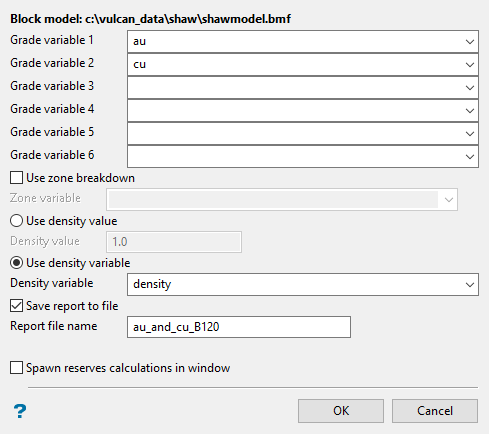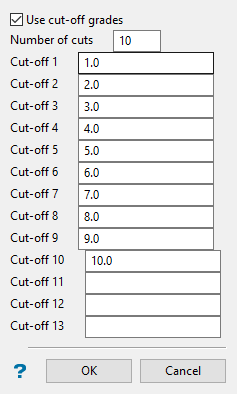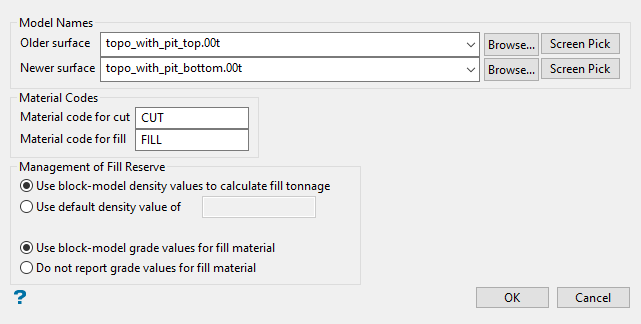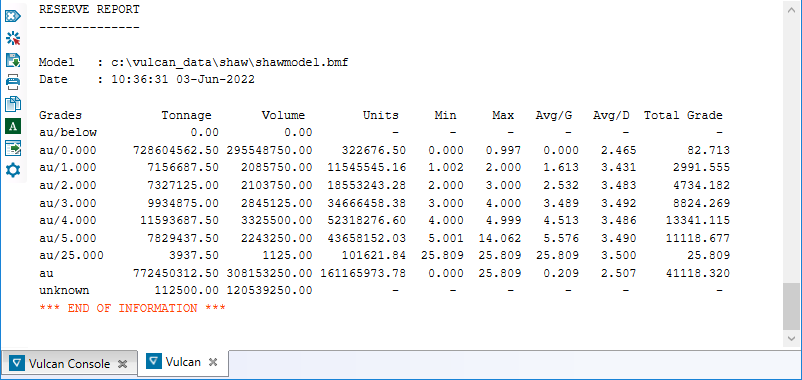General
Use this option to calculate reserves for up to six grade variables using multiple block selection criteria. You can use up to 13 grade cutoffs and report the breakdown by a zone variable.
Use the Advanced Reserves Editor option to perform more complex reserve calculations.
Instructions
On the Block menu, point to Reserves, then click General.

Note: An existing block model needs to be estimated and opened before starting this option. The directory path and name of the currently open block model will be displayed at the top of the panel.
Follow these steps:
-
Specify at least one grade variable. Up to 6 grade variables may be used in the calculation.
-
Select Use zone breakdown if you want to use a zone variable.
Example: You might use a geology variable with a value of
orezone.
-
Specify the density. The density can either be a variable within a density field in the block model or a constant value.
-
Check Save report to file if you want to save the calculated reserves within a nominated report file. Provide a name for the report file.
Note: The name can contain up to 20 alphanumeric characters and cannot have any spaces. By default, the resulting file will be placed within your current working directory.
-
If you want to run the calculations in another window, check Spawn reserves calculations in window.
Tip: This will free the current window for further Vulcan work.
-
Click OK to advance to the next panel.

-
Check Use cut-off grades if you wish to set cut-off thresholds. Enter the number of cuts to use, then the cut off values (up to 13).
This feature is optional. If no cut-offs are applied, then the results will report all reserves found in the block model. If cut-offs are provided, then the results will include reserves only for the cutoffs listed.
Each cut-off threshold will contain all block grades at or below the entered value.
-
Click OK to advance to the next panel.

By default, Select all blocks will be automatically selected for the reserve calculations. If you wish to leave the default setting as it is, then you do not need to do anything with this panel. However, if you want to limit which blocks are used, enable the option to Select specific blocks. This will make all the other options available.
Set the criteria for which blocks will be used by selecting one or more of the following options:
Important: Block selection is cumulative. Therefore, all arguments defined on this panel must be satisfied for a block to be included.
Available options.
 Variable
Variable
Select this check box to restrict the blocks by a block model variable. You will need to specify the variable, as well as a particular value.
Example: To restrict blocks to those where Material equals Ore, select Material as the variable from the drop-down list and enter
Oreas the value. However, if you require all blocks that do not have this specified value, then enable the Reverse matching check box. The block model variable may be numeric (for example the grade variable Au) or character (for example Geology) variables. Bounding triangulation
Bounding triangulation
Select this check box to restrict the blocks by a triangulation. This is useful when, for example, you want to evaluate reserves within a particular solid triangulation such as a stope.
To select blocks outside of the bounding triangulation, select the Select blocks outside the solid only option.
You may also select the Use block centres check box and use it with this restriction.
Note: This option is not applicable to open or 2D triangulations.
 Bounding box
Bounding box
Select this check box to restrict the blocks by a box. If you select this option, you must enter the minimum and maximum coordinates for X, Y, and Z in the block model coordinates (X. Y, Z CENTRE). If the block model origin is set at 0,0,0, then real world coordinates should be entered in the x y z minimum and maximum coordinates. If the block model origin is set at real world coordinates, then enter coordinates for the bounding box that are offset a certain distance from the origin. The distance of offset will be determined by the dimensions of your bounding box. It will be the distance to the minimum and the distance to the maximum X, Y and Z from the origin of the block model.
 Section thickness
Section thickness
Select this check box to restrict the blocks by a section plane. You will need to enter its associated thickness. The blocks that are within this thickness will be selected.
The section plane can be selected by line, points or grid coordinates. This information is entered through the Section Plane panel, which is displayed once the Block Selection panel has been completed. You may also select the Use block centres check box and use it with this restriction.
 Condition
Condition
Select this check box to use a further constraint upon a numeric block model variable, for example Fe GT 10.0 (iron value greater than 10.0). The maximum size of the condition is 132 alphanumeric characters. A list of available operators/functions to use when defining this condition is provided in Appendix B of the Vulcan Core documentation.
 Bounding surfaces
Bounding surfaces
Select this check box to restrict the blocks by bounding surfaces. Once the Block Selection panel has been completed, you will be required to select (from the screen) the top and bottom surface triangulations. Only blocks that lie within the overlapping sections, as viewed in plan view, of the surfaces are selected. You may also select the Use block centres check box and use it with this restriction. This check box will be disabled when the Cut and fill surfaces check box is in use.
 Cut and fill surfaces
Cut and fill surfaces
Select this check box to restrict the blocks to those that fall within two intersecting surfaces. This check box will be disabled when the Bounding surfaces check box is selected.
The required triangulation surfaces are specified through the Cut and Fill Surfaces Selection panel, which is displayed once the Block Selection panel has been completed.

Model names
Older surface
Enter, or select from the drop-down list, the name of the old triangulation surface. Click Browse to select a file from another location.
Newer surface
Enter, or select from the drop-down list, the name of the newest triangulation surface. Click Browse to select a file from another location.
Material codes
Material code for cut / Material code for fill
Enter the material codes for the fill and cut.
Management of fill reserve
 Reverse matching
Reverse matching
Select this check box to select outside the specified regions. See the description of the Variable field. This check box will be disabled when the Cut and fill surfaces check box is in use.
This check box is only available when using the Advanced Reserves Editor, or when limiting the block selection by a bounding box, triangulation or surfaces.
 Use block centres
Use block centres
Select this check box if you want to use the full cell evaluation method. If this check box is not selected, then the proportional cell evaluation method will be used instead.
-
Full cell evaluation: Include blocks if the block centroid is within the region. The entire block will be included.
-
Proportional cell evaluation: Include those blocks that touch the region, and evaluate reserves according to the proportion of the block's volume that lies within the region. Proportional cell evaluation calculates and reports the exact proportion of a block within a solid triangulation. When selecting blocks, all blocks that touch the region are selected.
-
Click OK to calculate reserves.
The Reserve Report will be displayed in the Vulcan Report Window.

It will also be saved to a (.brf) output file if that option was utilised. The report file is a standard ASCII file that can be viewed in the Workbench Text Editor, or in any other text editor.


